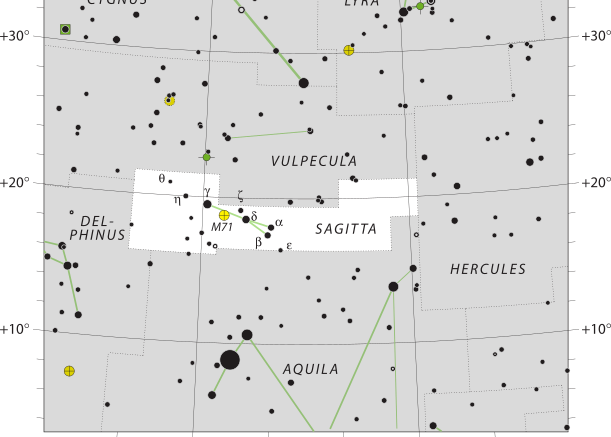Located in the northern sky, the constellation Sagitta is dim but distinctive. The name Sagitta in Latin means “arrow”, but should not be confused with the larger constellation of Sagittarius, the archer. Sagitta was included among the 48 constellations listed by the 2nd century astronomer Ptolemy. Although it dates to antiquity, Sagitta has no star brighter than 3rd magnitude and has the third-smallest area of all constellations.
Gamma Sagittae is the brightest star, with an apparent magnitude of 3.47, which is a red giant star that is 90% as massive as the Sun. Stars Delta, Epsilon, Zeta and Theta Sagittae are each multiple stars whose components can be seen in small telescopes. V Sagittae is a cataclysmic variable—a binary star system composed of a white dwarf accreting mass of a donor star that is expected to go nova and briefly become the most luminous star in the Milky Way and one of the brightest stars in the sky around 2083.
The 4 brightest stars in the constellation make up an arrow-shaped asterism located due north of the bright star Altair. Covering 79.9 square degrees and hence 0.194% of the sky, Sagitta ranks 86th by area. Only the constellations Equuleus and Crux are smaller in size.
| Applicable Information | |
| Visibility In Pacific Northwest | April to October |
| Best Times To View | August |
| Right Ascension | 19.8333h |
| Declination | −18.66° |
| Area | 80 square degrees |
| Main Stars | 4 |
| Brightest Object | γ Sge |
| Meteor showers | 0 |
| Messier objects | 1 |
| Neighboring Constellations | Vulpecula, Hercules, Aquila, Delphinus |
History
The ancient Greeks called Sagitta Oistos or “the arrow” in English, and it was one of the 48 constellations described by Ptolemy. It was regarded as the weapon that Hercules used to kill the eagle, Aquila, of Jove that perpetually gnawed Prometheus’ liver. It makes sense that in the sky, Sagitta is located beyond the north border of Aquila, the Eagle.
The Romans named the constellation Sagitta. In Arabic, the constellation became al-sahm “arrow”, though this name became Sham and was transferred to Alpha Sagittae only.
Stars
Celestial cartographer Johann Bayer gave Bayer designations to 8 stars, which went from Alpha to Theta.
There are several stars with exoplanets.
The band of the Milky Way and the Great Rift pass though Sagitta, with the stars Alpha, Beta and Epsilon Sagittae marking the Rift’s border.
Located between Beta and Gamma Sagittae is Messier 71, a very loose globular cluster which was mistaken for a dense open cluster. It was first discovered by the French astronomer Philippe Loys de Chéseaux in the year 1745 or 1746.
There are two notable planetary nebulae in Sagitta: NGC 6886—composed of a hot central post-AGB star that has 55% of the Sun’s mass yet 2,700±850 times its luminosity, with a surface temperature of 142,000 K, and surrounding nebula estimated to have been expanding for between 1,280 and 1,600 years,[61] and the Necklace Nebula—originally a close binary, one component of which swallowed the other as it expanded to become a giant star. The smaller star remained in orbit inside the larger, whose rotation speed increased greatly, resulting in it flinging its outer layers off into space, forming a ring with knots of bright gas formed from clumps of stellar material.[62] Both nebulae are around 15,000 light-years from Earth.[61][62]
Make sure to check out other articles on the site, including a brief introduction to constellations, other constellation articles, and more!

Be the first to comment on "Sagitta"